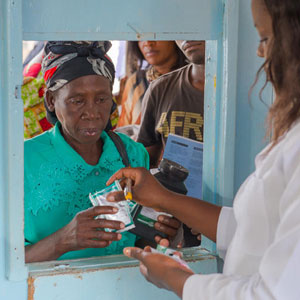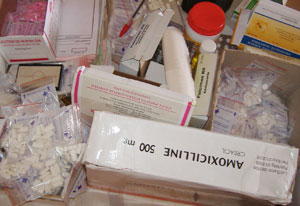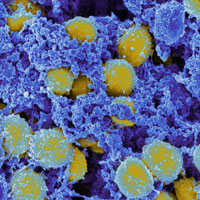Global leaders raise alarm on antibiotic resistance
July / August 2014 | Volume 13, Issue 4

Photo by Gareth Bentley/SCMS, courtesy of Photoshare
Global health authorities, alarmed about the spread of
antibiotic resistance, are urging more surveillance, as
well as development of new diagnostic tests and drugs.
Poor diagnostic tools, inappropriate use of antibiotics and a lack of new replacement drugs are causing a global crisis of antimicrobial resistance, according to global health leaders.
"A post-antibiotic era - in which common infections and minor injuries can kill - far from being an apocalyptic fantasy, is instead a very real possibility in the 21st century," warned WHO's Assistant Director-General for Health Security Dr. Keiji Fukuda. The WHO recently issued its
first-ever global report on antibiotic resistance, deeming it a serious, worldwide threat to public health.
"Unless we take significant actions to improve efforts to prevent infections and also change how we produce, prescribe and use antibiotics, the world will lose more and more of these global public health goods and the implications will be devastating," according to Fukuda.
At the NIH, experts said researchers play a critical role in the unending battle against antimicrobial resistance. In March, the National Institute of Allergy and Infectious Diseases (NIAID) published a
report [PDF <1M, 15 pages] concerning the threat, laying out its strategy to refocus its research efforts to address key scientific challenges. Under the plan, NIAID will examine the comprehensive biology and genetic makeup of specific microbes to understand how bacteria become resistant and will also identify new targets for point-of-care diagnostics. In addition, it will develop vaccines to prevent infection with drug-resistant microbes and design new antibiotics, among other priorities.
"As long as antibiotics are used to kill bacteria, resistance will continue to emerge," the NIAID report noted, and as this resistance builds, scientists are in a race to 'outsmart' the bacteria by working around the mechanisms that cause resistance.
In a
related commentary in the
Journal of the American Medical Association (JAMA), NIAID Director Dr. Anthony S. Fauci and colleague Dr. Hilary D. Marston called antibiotic resistance "a global crisis." They urged colleagues around the world to act on many fronts at once, especially in developing countries, where "the challenges are compounded by limited capacity for surveillance and poorly regulated sales."

Photo by Rachel Hoy/Photoshare
Antibiotic consumption is rising rapidly, especially in
developing countries, where sales are often unregulated.
Global antibiotic consumption increased by an astonishing 36 percent between 2000 and 2010, according to a
recent article published in
The Lancet. Dr. Ramanan Laxminarayan and colleagues found much of the growth occurred in low- and middle-income countries where "antibiotics are used as a substitute for public health measures," and over-the-counter sales are unregulated.
Health authorities must promote more judicious use of antibiotics and develop new infection prevention measures, according to the NIAID report. This necessarily involves collaborations among partners from different disciplines and swiftness in identifying and acting on threats as they emerge. NIAID noted, "Because antibiotic resistance is a complex problem with many drivers, combating it requires a multifaceted approach."
Other scientists are more focused on developing tools to properly identify bacterial infections and prevent their spread in the first place. As Fauci and Marston noted, "The importance of accurate diagnostics at point-of-care in efforts to thwart antimicrobial resistance cannot be overstated." These tools can help expand surveillance and curb inappropriate antibiotic use, for instance by distinguishing between viral and bacterial causes of respiratory illnesses - the majority of which are viral but are often incorrectly treated with antibiotics.
"We need a new independent body that will not only monitor the spread of antimicrobial resistance, but also drive and direct efforts to contain it," said Farrar.
Some encouraging changes are already underway in the bacteria battle, Fauci and Marston noted in their recent article. Industry incentives, such as longer market exclusivity, are encouraging drug development and currently 14 novel antibacterial agents are being tested for their effectiveness in humans. Meanwhile, hospitals around the world are devising systems to prevent patients developing opportunistic infections during their stay.

Photo courtesy of NIAID
Scientists are concerned that deadly
bacteria, such as staph, might
become resistant to antibiotics.
The NIAID continues to fund research to add to the arsenal available to combat harmful bacteria. In one project, a potential novel class of antibiotics targeting resistant
Staphylococcus aureus is now in a trial to test its safety. A new $12 million NIAID initiative aims to develop new diagnostics that can quickly detect the resistant bacteria commonly found in hospitals. Other potential tacks for stopping harmful bacteria include creating vaccines, enlisting harmless bacteria already in the microbiome to bolster the body's defenses and spurring monoclonal antibodies that attack bacterial proteins.
In the U.S., a recent assessment of antibiotic resistance by the CDC found more than two million people each year get infections that are resistant to antibiotics and at least 23,000 people die as a result. The report classified the threats posed by the antibiotic-resistant germs. Deemed most urgent were drug-resistant gonorrhea, carbapenem-resistant Enterobacteriaceae, and
Clostridium difficile, a serious diarrheal infection usually associated with antibiotic use.
C. difficile alone causes about 250,000 hospitalizations and at least 14,000 deaths in the U.S. every year.
"The bottom line is that we have to protect patients by protecting antibiotics," said CDC Director Dr. Tom Frieden. "The drugs we have today are endangered. And any new drugs we get could be lost just as quickly if we don't improve the way we prescribe and use them."
In its analysis of antimicrobial resistance data from 114 countries, the WHO emphasized that every part of the world is affected and a coordinated response is imperative. The study found resistance across many different types of infectious pathogens, but focused on antibiotic resistance in nine different bacteria responsible for common, serious diseases. These include bloodstream infections (sepsis), diarrhea, pneumonia, urinary tract infections and gonorrhea. It's of "high concern" that bacteria have developed some resistance to all -including last-resort - antibiotics in all regions of the world, the report said. Aside from the risk of serious illness and death, resistance also burdens health system budgets, with lengthier hospital stays and more intensive care needs.
At a recent meeting, the WHO's General Assembly, delegates urged member countries to strengthen their antimicrobial drug management systems, support research to prolong the lifespan of current antibiotics, and spur new diagnostics and treatments for microbial infections. The WHO is now preparing a draft global action plan against antimicrobial resistance to be voted on in 2015.
"This serious threat is no longer a prediction for the future," the WHO report noted. "It is happening right now in every region of the world and has the potential to affect anyone, of any age, in any country."
Antimicrobial Resistance Research Resources
Access leading resources and articles on the increasing health risks tied to antimicrobial resistance.
-
New strategies in battle against antibiotic resistance
NIH Director's Blog, September 18, 2014 - Report:
Antimicrobial resistance: global report on surveillance 2014
World Health Organization (WHO), April 2014 - Report:
NIAID's Antibacterial Resistance Program - Current Status and Future Directions 2014 [PDF <1M, 15 pages]
National Institute of Allergy and Infectious Diseases (NIAID), released March 2014 - About
Antimicrobial (Drug) Resistance
from the National Institute of Allergy and Infectious Diseases (NIAID) -
The Perpetual Challenge of Antimicrobial Resistance
Journal of the American Medical Association, May 14, 2014 -
Global antibiotic consumption 2000 to 2010: an analysis of national pharmaceutical sales data
The Lancet, July 10, 2014 -
Policy: An intergovernmental panel on antimicrobial resistance
Nature, May 22, 2014 - About
Antibiotic / Antimicrobial Resistance
from the Centers for Disease Control and Prevention (CDC) - NIH Request for Information:
Antimicrobial Resistance Rapid, Point-of-Care Diagnostic Test Challenge
Respond by July 17, 2015 -
HHS forges unprecedented partnership to combat antimicrobial resistance
HHS news, July 28, 2016
To view Adobe PDF files,
download current, free accessible plug-ins from Adobe's website.